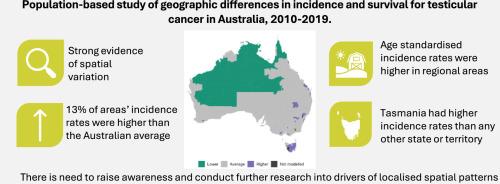2010-2019年澳大利亚睾丸癌诊断的空间格局
IF 1.7
Q3 PUBLIC, ENVIRONMENTAL & OCCUPATIONAL HEALTH
引用次数: 0
摘要
目的利用澳大利亚全国人口癌症登记数据,调查2010年至2019年期间澳大利亚睾丸癌发病率的空间格局和生存的广泛区域差异。方法从澳大利亚癌症数据库获得包括诊断时居住地点在内的发病率数据,并对死亡率进行随访,直至2019年底。发病率空间模式采用贝叶斯空间Leroux模型建模,空间异质性采用最大超额事件检验。采用灵活参数相对生存模型对大区域的相对存活率进行建模。结果8217例睾丸癌报告中,年年龄标准化发病率为8.9例/ 10万男性。我们发现,在小的地理区域中,睾丸癌的发病率存在显著的空间差异,包括塔斯马尼亚州在内的一些地区的标准化发病率高于全国平均水平。5年相对生存率估计为97.5% [95% CI: 97.1-97.9]。结论有必要提高对睾丸癌高危地区和年龄人群的认识,并进一步研究局部空间格局的驱动因素。本文章由计算机程序翻译,如有差异,请以英文原文为准。

Spatial patterns of testicular cancer diagnosis in Australia, 2010-2019
Aim
To investigate the spatial patterns of the incidence rates of testicular cancer, and broad regional differences in survival, between 2010 and 2019 in Australia using national population-based cancer registry data.
Methods
Incidence data including residential location at diagnosis were obtained from the Australian Cancer Database, with mortality followed-up until end of 2019. Incidence spatial patterns were modelled using Bayesian spatial Leroux models and spatial heterogeneity tested using the maximised excess events test. Relative survival rates by broad region were modelled using flexible parametric relative survival models.
Results
From all the notifications of testicular cancer (n = 8217), the age-standardized incidence rate was 8.9 cases per 100,000 males each year. We found evidence of significant spatial variation in the incidence of testicular cancer across small geographical areas, with some areas including those in Tasmania showing standardised incidence ratios above the national average. The 5-year relative survival estimate was 97.5 % [95 % CI: 97.1–97.9].
Conclusion
There is a need to raise awareness of testicular cancer in high-risk geographical areas and age groups, and to conduct further research into drivers of localised spatial patterns.
求助全文
通过发布文献求助,成功后即可免费获取论文全文。
去求助
来源期刊

Spatial and Spatio-Temporal Epidemiology
PUBLIC, ENVIRONMENTAL & OCCUPATIONAL HEALTH-
CiteScore
5.10
自引率
8.80%
发文量
63
 求助内容:
求助内容: 应助结果提醒方式:
应助结果提醒方式:


